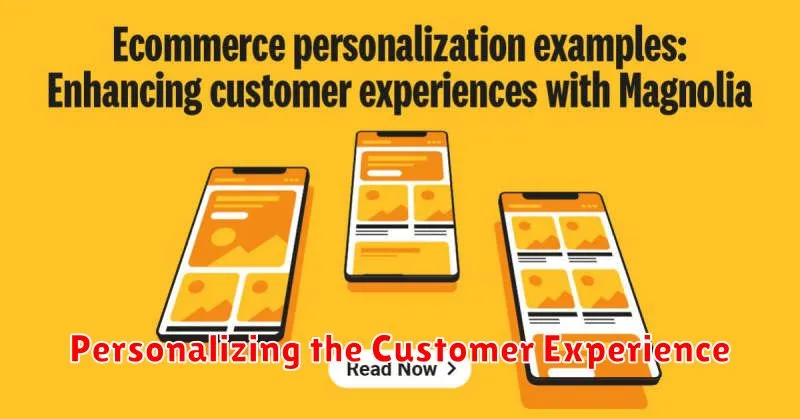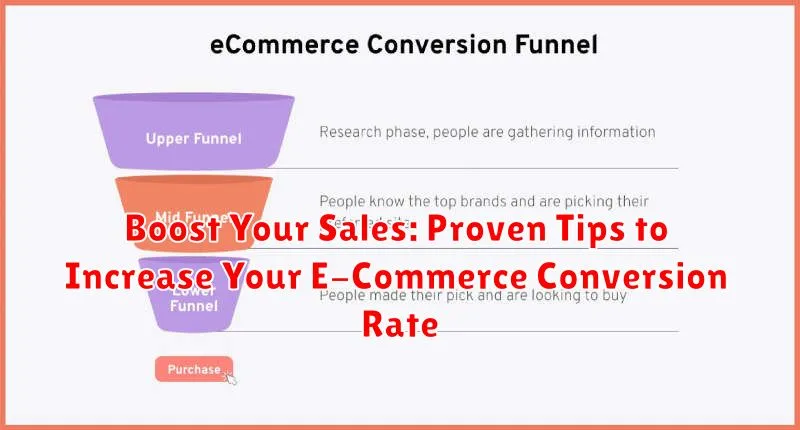Are you struggling to convert website visitors into paying customers? Do you want to boost your sales and see a significant increase in your e-commerce conversion rate? This article provides proven tips and actionable strategies to help you optimize your online store and drive more conversions. Learn how to transform browsing shoppers into loyal buyers and unlock the full potential of your e-commerce business. From optimizing your website design and user experience to implementing effective marketing tactics, we’ll cover everything you need to know to achieve sustainable growth.
This comprehensive guide offers practical advice on enhancing key aspects of your e-commerce platform. Discover how to improve product presentation, streamline the checkout process, and build trust with potential customers. We’ll explore the importance of persuasive calls to action, targeted marketing campaigns, and data-driven analysis to boost your sales. By implementing these proven tips, you can significantly increase your e-commerce conversion rate and maximize your return on investment. Let’s dive in and uncover the secrets to e-commerce success.
Understanding Your Target Audience
A deep understanding of your target audience is crucial for increasing e-commerce conversions. Knowing your ideal customer informs every aspect of your sales strategy, from product development to marketing campaigns.
Start by identifying key demographics such as age, gender, location, income level, and education. This foundational data provides a basic understanding of your customer base.
Go beyond demographics and explore psychographics. What are their interests, values, and lifestyles? Understanding these factors allows you to tailor your messaging and product offerings to resonate with their needs and desires.
Analyze their online behavior. Which platforms do they frequent? What kind of content do they engage with? These insights will inform your marketing efforts and help you reach them where they are most active.
By building a comprehensive profile of your target audience, you can create a more personalized and effective sales approach, ultimately leading to higher conversion rates.
Optimizing Your Website for Conversions
A website optimized for conversions encourages visitors to take desired actions, ultimately leading to increased sales. Website speed is paramount. A slow-loading site can lead to high bounce rates, directly impacting conversions. Optimize images, leverage browser caching, and minimize HTTP requests to improve loading times.
Clear calls to action (CTAs) are essential. Use action-oriented language and visually prominent buttons to guide users towards desired actions, such as “Add to Cart” or “Shop Now.” Placement of CTAs is crucial; strategically position them throughout the site, particularly on product pages and landing pages.
Intuitive navigation is key. Users should easily find what they’re looking for. Implement a logical site structure with clear categories and subcategories. A search bar also allows users to quickly locate specific products.
Mobile responsiveness is no longer optional; it’s a necessity. Ensure your website adapts seamlessly to various screen sizes, providing a positive user experience across all devices. This is vital for capturing conversions from mobile users.
Creating Compelling Product Descriptions
Product descriptions are your digital sales representatives. They communicate the value and benefits of your products to potential customers. Compelling descriptions go beyond simply listing features; they entice the buyer and answer the unspoken question, “What’s in it for me?”
Focus on writing benefit-driven descriptions that highlight how the product solves a problem or improves the customer’s life. Use vivid language and sensory details to paint a picture of the product in action. Imagine the customer using your product and describe that experience.
Keywords are essential for search engine optimization (SEO). Naturally incorporate relevant keywords into your descriptions, but prioritize clarity and readability. Don’t stuff keywords into the text; focus on creating a natural flow.
Consider using a structured format, including bullet points or short paragraphs, to make the information easily digestible. This allows customers to quickly scan and absorb the key selling points.
Streamlining the Checkout Process
A complicated checkout process is a major barrier to conversion. Simplify and optimize every step to create a frictionless experience for your customers. Reduce the number of required fields, offer guest checkout options, and clearly display shipping costs and delivery times upfront.
Offer various payment methods to cater to different customer preferences. This might include credit and debit cards, digital wallets like PayPal or Apple Pay, and even “buy now, pay later” options. Ensure your payment gateway is secure and reliable to instill trust and confidence in your customers.
Mobile optimization is crucial. A significant portion of online shopping happens on mobile devices. Your checkout process must be fully responsive and easy to navigate on smaller screens.
Progress indicators can visually guide customers through the checkout steps, letting them know how close they are to completing their purchase. This can help reduce cart abandonment by providing a sense of accomplishment and encouraging completion.
Leveraging Social Proof to Build Trust
Social proof is a powerful tool for building trust and encouraging conversions. Customers are more likely to purchase from a brand they perceive as reputable and reliable. Displaying social proof signals effectively can significantly impact your bottom line.
Customer testimonials are a classic form of social proof. Feature authentic reviews and testimonials directly on your product pages. Highlight positive experiences and address common concerns potential customers might have.
Showcase your number of sales or customers served. If you’ve reached a significant milestone, such as “Serving over 10,000 satisfied customers,” make it visible on your website.
Expert endorsements can add another layer of credibility. If relevant industry experts have praised your products or services, feature their endorsements prominently.
Social media engagement can also serve as social proof. Displaying your social media follower count, or embedding a live social media feed, can demonstrate the size and activity of your online community.
Offering Competitive Shipping and Returns
In the competitive e-commerce landscape, shipping and returns are critical factors influencing purchase decisions. Customers are highly sensitive to shipping costs and the ease of returning unwanted items. Offering competitive options in these areas can significantly impact your conversion rate.
Consider offering free shipping, especially for orders above a certain threshold. This can be a powerful incentive for customers to complete their purchase. Clearly display your shipping costs and estimated delivery times upfront to avoid any surprises at checkout. Transparency builds trust and encourages conversions.
A hassle-free return policy is equally important. A clear and easy-to-understand return process reduces purchase anxiety and fosters customer confidence. Offer options like prepaid return labels and extended return windows to enhance the customer experience and boost sales.
Evaluate your competitors’ shipping and return policies to understand the current market standards. Strive to offer options that are as good as, or better than, your competition to gain a competitive edge.
Using High-Quality Product Images and Videos

In the world of e-commerce, visuals reign supreme. High-quality product images and videos are crucial for showcasing your products effectively and driving conversions. Customers cannot physically touch or examine your products, so compelling visuals bridge that gap. They provide a virtual experience that informs and persuades.
Invest in professional photography or videography to capture your products in the best light. Showcase different angles and highlight key features. Consider lifestyle shots to demonstrate how the product is used in real-world scenarios. For example, if you’re selling a backpack, show it being used on a hike. If you’re selling kitchenware, display it in an attractive kitchen setting.
Video content can further elevate the customer experience. Short product demonstrations or 360-degree views can offer a dynamic perspective, allowing customers to thoroughly examine the product. This increased interaction can significantly boost customer confidence and ultimately, sales.
Personalizing the Customer Experience

In today’s competitive e-commerce landscape, personalization is key to driving conversions. Customers expect a tailored experience that caters to their individual needs and preferences. By leveraging data and implementing strategic personalization tactics, you can significantly enhance the customer journey and boost your bottom line.
Product Recommendations are a powerful tool. Suggesting relevant items based on browsing history, past purchases, or even items frequently bought together can encourage additional sales. Targeted promotions and offers are another effective strategy. By offering discounts on products that align with a customer’s interests, you increase the likelihood of a purchase. Consider using personalized email marketing campaigns featuring curated product selections or exclusive deals.
Addressing customers by name in communications adds a personal touch. Further enhancing this experience can involve providing customized content, like blog posts or style guides, tailored to their expressed interests. This creates a more engaging and relevant experience, fostering a stronger connection with your brand.
A/B Testing to Continuously Improve
A/B testing, also known as split testing, is a crucial strategy for optimizing your e-commerce store and boosting conversions. It involves comparing two versions of a webpage element to see which performs better. This data-driven approach eliminates guesswork and allows you to make informed decisions based on actual customer behavior.
You can A/B test virtually any element on your website, including:
- Headlines: Test different wording and phrasing to see what resonates best with your audience.
- Call-to-action buttons: Experiment with color, size, placement, and text to optimize click-through rates.
- Product descriptions: Compare long vs. short descriptions, different tones, and benefit-focused vs. feature-focused copy.
- Page layout: Test different arrangements of elements to improve user experience and navigation.
By consistently running A/B tests and analyzing the results, you can continuously refine your website and improve its performance. Small changes can often lead to significant improvements in your conversion rate and overall sales.

